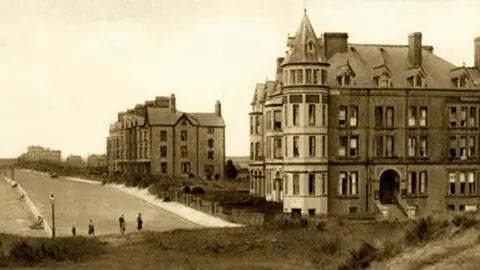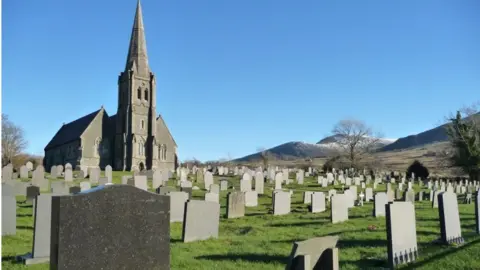Pwllheli Sunday school boating tragedy marked by QR codes
 Rhiw.com
Rhiw.comThe drowning of 12 people on a Sunday school outing more than 120 years ago is to be marked by QR codes linking to online information about the tragedy.
Three parents and nine children from Gwynedd died after hiring a rowing boat for a trip off Pwllheli's South Beach promenade in 1899.
Their deaths shocked and devastated the community.
QR codes, which can be scanned by smartphones, have been installed at two sites linked to the tragedy.
They are part of the HistoryPoints project, which aims to help the public learn about the history of local places via 1,900 codes and corresponding web pages for locations across Wales.
Oarsman Robert Thomas was just 18 when he agreed to take the party from the Llanberis area out for an hour's excursion in his boat on 1 July 1899.
Originally, only nine people had signed up but by the time they set off three more children had joined, later prompting questions as to whether the tiny vessel had been overloaded.
A mile off Pwllheli (1.6km), Mr Thomas attempted to turn for home, when a freak wave hit the rowing boat.
Mr Thomas would be the only survivor and, while fingers were initially pointed in his direction, Rhodri Clark of HistoryPoints said he was entirely exonerated at an inquest.
"The jury heard that, after the wave had struck, one of the children onboard - 12-year-old Johnny Hughes - shouted to his father that there was water in the stern," he said.
"Ignoring Mr Thomas's command - 'For God's sake, man, don't move!' - Johnny's father, John, went from the bow to the back of the boat to investigate and the extra weight submerged the stern."
Mr Clark said the inquest jury thought this action aggravated the initial impact of the wave.
Indeed, Mr Thomas tried his best to keep one of the children alive when they were in the water.
"At the inquest, it emerged that Pwllheli council had previously been concerned about the safety of boats taking members of the public on short trips out to sea.
"In 1897, the council had applied to Parliament for power to compel all boat owners to license their boats, but the House of Lords deleted the clause.
"The inquest jury recommended the council should apply for compulsory powers for registration of local boats," he said.
 Geograph / Christine Johnstone
Geograph / Christine Johnstone HistoryPoints has installed QR codes on the promenade and also at Christ Church, Deiniolen, where a joint funeral was held for 11 of the victims.
One newspaper said of the occasion: "The scene had no parallel in the annals of this part of north Wales."
The Reverend James Salt conducted a collective service, which closed with the hymn Bydd Myrdd o Ryfeddodau.
All along the route to the church blinds were drawn and the local slate quarry was closed for the day to allow 3,000 mourners to follow the funeral procession.
Mr Clark said the impact on such a small village was felt for decades to come.
"Johnny's mother Jane Hughes - who was pregnant and had missed the day trip because she felt unwell - had lost her husband and all three of her children.
"Almost everyone in the village would have been touched by the tragedy in some way."
Mr Clark said, with this year's summer holidays about to start, he hoped the information about the tragedy would serve as a reminder to visitors about the dangers of the sea around the north Wales coast.
